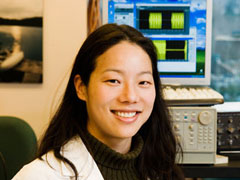In Small Packages
By Laura Pratt
Drop a barrier in front of Dr. Naomi Matsuura, a postdoctoral fellow in imaging research at Sunnybrook Research Institute (SRI), and stand clear on the other side of it. She’ll be through presently, proficient as she is in devising solutions to impossible problems.
Matsuura’s interests lie in imaging, and in applying nanotechnology principles to enhance existing modalities’ effectiveness such that scientists can detect diseased tissue to a far greater degree than ever before. Conventionally, researchers have been limited to viewing only large metabolic changes in tissue as indication of the contrasts that are the hallmarks of abnormalities. In the future, says Matsuura, the goal is to localize those contrasting agents to a nano level (nano refers to a field of applied science and technology whose unifying theme is the control of matter on the atomic and molecular scale, normally one to 100 nanometers, and the fabrication of devices within that size range), such that lower-than-ever concentrations of diseased tissue can be detected. "People have been using nanotechnology in drug delivery for years," she says. "But the concept of using [it] for imaging is relatively new."
Matsuura, a research associate in Dr. John Rowlands’ lab at SRI, recently won the Ontario Council on Graduate Studies John Charles Polanyi prize, awarded to outstanding researchers in the early stages of their career, to pursue this work. She will use this $20,000 grant to help build her team. "It frees up some financial constraints," she says.
Matsuura likes nothing better than to receive word from a researcher of a particular need, and to address it by adapting existing technologies into something new. She is mindful of the value of integration in the most successful strains of research. Most people faced with a requirement for a tool that has yet to be invented, says Matsuura, "just take what they can get. They’re not aware that it’s conceivable to change an existing design or design something new, on a nano scale, that perfectly meets their requirements."
Collaboration, says Matsuura, who hails from a background in physics, is key. She designs her materials in close consultation with the person behind the request. In the "whole intertwined mess of disease, imaging and treatment," Matsuura works to stay relevant. "We have lots of well-known and experienced scientists here, all of whom are very open. I can talk to them and see if we can integrate the structures we’ve developed or the principles we’re working on in imaging to the biological systems."
Matsuura loves her job, and the opportunity it affords her to explore the role of nanotechnology in the medical imaging field. "There’s been a lot of hype around that, but in some ways, it has yet to be borne out," she says. "We’re trying to make a long-term contribution. And it’s a long journey."
PDF / View full media release »





